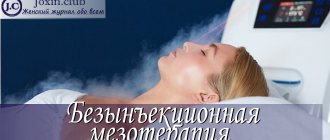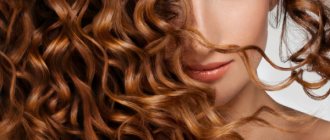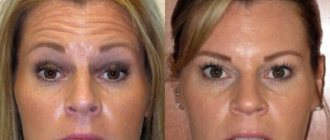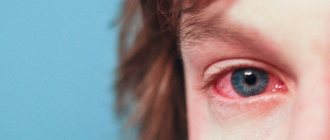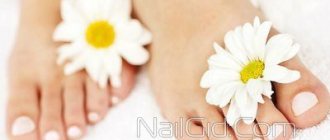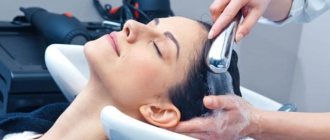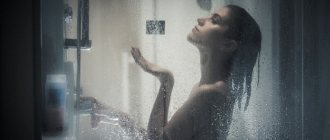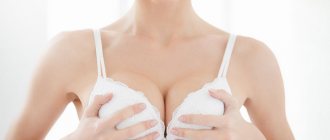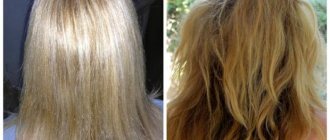Thread lifting - what is it?
Thread lifting is a face and body lift with implants in the form of threads, which are made from so-called biocompatible materials. Basically, these are synthetics (precious metals in the original models), which “take root” in the body and do not cause tissue rejection.
The threads can be absorbable or non-absorbable - with both, the procedure is approximately the same. A hollow cannula needle is inserted into soft tissue (usually into the dermis, the middle layer of skin), a channel is made, a thread is inserted into this channel and it is secured in one of the possible ways. The thread tightens the skin, and the lifting effect is noticeable immediately after the procedure. Then it will only manifest itself more strongly - due to the fact that metabolic processes always occur faster in injured tissue and cell division is more active. So within a month, the implant threads are completely overgrown with dense connective tissue - this is what makes the skin elastic and smooth. By this time, the thread itself will disintegrate - compounds useful for the body will be absorbed by the cells, and unnecessary fluid will be removed from the body. Absorbable implants are thus placed for a short period of time and have a short service life, no more than two months. The lifting effect occurs more due to the body’s own resources - the younger the woman, the better the result of the procedure will be.
Non-degradable implants work differently. After reinforcement, the main load will fall on them. Such threads - at first they were made of metal like gold or platinum, now from synthetics - after implantation they become the main “supporting structure”. Tissue tension and, accordingly, the degree of rejuvenation depend more on the quality and quantity of implants than on the patient’s age.
Non-absorbable threads are often used in “complicated” cases - with severe ptosis of the face and in certain areas of the body - where the volume of sagging tissue is too large and where a supporting “frame” is indispensable. True, doctors say that threads are rarely placed on the body - even if the patient has indications for the procedure, he should be warned that the result will be short-lived. Thread lifting is more appropriate (and useful) on the face with a small degree of ptosis and shallow wrinkles.
Dr. D. A. Gruzdev about thread lifting - video
Cost of non-surgical thread lifting
Depending on the type and number of threads, the cost of one zone can range from 11,000 to 55,000 rubles. The price of one 3D mesothread averages 800-2000 rubles; one Silhouette Lift thread – 6000-8000 rubles; Aptos - 1600-3000 rubles; Resorblift - 1300-2500 rubles.
Non-surgical face lift with Silhouette Soft threads
Face lift with Aptos Excellence Visage threads
Lift without surgery 4D threads made in Korea
Tags: plastic surgery
Market Analytics
- Black Lives Matter movement: reaction and consequences for the beauty industry
- COVID-19 is changing the rules of the game in the cosmetics market
- Beauty of the future: cosmetic innovations 2020
Convenient search for beauty salons on our website
Beauty salons in Moscow Beauty salons in St. Petersburg Beauty salons in Ekaterinburg Beauty salons in Novosibirsk
Latest blog posts on our website
- Naturecream / MATRIXYL3000 - the best skin elasticity stimulator
- Naturecream / SPF in Natural Oils
- Naturecream / Geranium (Pelargonium) oil for skin health and beauty
- Prostye-sovety / Save on a beauty salon: procedures that can be done at home
- Naturecream / Growth Factor - brings back youth?
- Oksana-Lezina / 3 effective abdominal exercises from a fitness instructor for beginners
- Prostye-sovety / Making perfect curls at home
- Prostye-sovety / Which hair removal method to choose
- Naturecream / Wrinkles Puppets
- Naturecream / PEPHA-TIGHT - instant skin lifting
Latest forum topics on our website
- Mrs._Smith / Badly sunburned! What to do?((
- Ice / Is it necessary to combine fitness classes with a diet?
- Antonova / What can be used for hair loss?
- Radio operatorKat / Who was on a protein diet?
- Suzanna / Mesotherapy on the face
Reviews about the procedure Non-surgical thread lifting
- Margarita | 2018-01-29 10:37:59 I had a difficult rehabilitation. I had a lift done with Aptos threads. The bruises and swelling took longer to go away than expected, but the threads had nothing to do with it. Apparently my body is like that.
[Leave a review]
Leave your review of this procedure (it will appear on this page after moderation)
In this form, describe only
your personal
experience of undergoing the procedure.
In order to leave a comment regarding the content of the article, use another form - in the “comments” block at the bottom of the page.
Other articles in this section
| Correction of cheekbones with fillers: features of the procedure, results, list of contraindications Modern cosmetic procedures help girls improve their appearance, correct minor defects, and hide age-related changes. More and more women are refusing plastic surgery and choosing more gentle methods. Correction of cheekbones with fillers is one of the most popular procedures in beauty salons. Ideal for ladies over 35 years old. The advantages are that the result is noticeable immediately, the rehabilitation period lasts no more than 3 days, and side effects are minimized. |
| Microblading Microblading of eyebrows and lips is a popular procedure among women. In this article we will tell you what it is, how this procedure is carried out, how microblading differs from permanent makeup using a device, what techniques are used in microblading. |
| How does a solarium affect the appearance of acne? In pursuit of a beautiful appearance, women are ready not only to do masks, massages, and play sports, but also to visit a solarium. However, few people think about how ultraviolet rays affect the skin. Solarium, like sunbathing, has both positive and negative effects on the dermis. For those with problem skin, after visiting a solarium, acne may disappear, or vice versa - it may progress. This article will tell you why acne may appear or disappear after solarium. |
| Hyaluronic acid in the lips Hyaluronic acid is injected into the lips in almost every beauty salon or cosmetology clinic - this is one of the most popular procedures among women of different age categories. The introduction of hyaluronic acid into the lips allows you to maintain youth and moisture, as well as add volume to the lips and correct their shape. |
| Face masks in beauty salons A face mask is one of the most common and affordable procedures offered by beauty salons as part of a complex of cosmetic procedures for facial skin care. As a manipulation, a mask involves applying a mixture of components of a certain composition to previously cleansed facial skin for a certain period of time in order to achieve the desired effect. |
| Japanese facial massage In this article you will get acquainted with the technique of Japanese facial massage Asahi (Zogan), which is aimed at rejuvenating and tightening the skin of the face. You can do this massage yourself; for this we have provided you with detailed instructions with pictures and videos. |
| Botox injections: is Botox harmful to the face? In this article we will talk about Botox injections: is Botox harmful, how does botulinum toxin work and what consequences may arise from its use. |
| Deep facial cleansing at home and in the salon Deep facial cleansing is a fairly simple procedure, but if performed incorrectly it can lead to skin injury. It is better to carry it out in a beauty salon, under the supervision of an experienced cosmetologist, but if you know the nuances of the procedure, deep cleansing of the skin can be carried out at home. In this article we will look in detail at how this procedure is performed correctly and how often it can be done. |
| Fillers based on hyaluronic acid In pursuit of means to prolong youth and preserve female beauty, cosmetologists are constantly developing new cosmetic techniques and products. One of the newest inventions in the field of facial and body contouring are fillers, which are filler preparations created on the basis of hyaluronic acid. They have virtually no contraindications for use, are well accepted by the body and do not give an inflammatory reaction, which is characteristic of synthetic substances. Such filler preparations ideally restore youth and beauty. |
| Threadlifting: what is it, reviews, before and after photos Threadlifting with mesothreads is very popular among girls of different ages. The technology came to us from Korea. The basis is based on acupuncture techniques. What features do you need to know about thread lifting, what is it? Are there any contraindications for the procedure? We will answer these and other questions in the article. |
Indications for the procedure
Thread lifting allows you to correct age-related problems and aesthetic imperfections on the face and body.
What can be done with threads - table
| Correction area | What results can be achieved with reinforcement? |
| Face |
|
| Body |
|
Before the age of 30, thread lifting is usually not necessary; at this age, injections of hyaluronic acid, vitamin cocktails or botulinum toxin may be offered to correct minor age-related changes.
The optimal age for thread lifting is from 30 to 50 years, although these age limits are flexible.
The decision on whether or not to carry out the procedure is made by a cosmetologist after assessing the condition of the skin.
The average age of patients who most often receive threads is 35–40 years
Stages of the procedure
According to reviews, the thread facelift procedure is carried out using a ready-made set of materials. It includes the thread itself and a needle into which the thread is already immediately threaded. Before the procedure, every woman is required to undergo a check to ensure there are no contraindications to lifting and pass all the necessary tests. After this, the specialist examines in detail all the patient’s data and the features of her face.
On the day of the procedure itself, the first thing to do is mark the thread lines and puncture points.
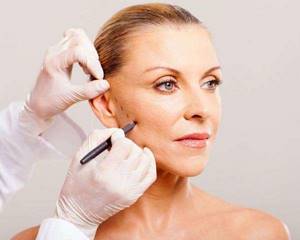
Then the specialist determines the most suitable material for a particular case, treats the skin with antiseptics and administers local anesthesia by injection.
Only after all the preparatory procedures is the insertion and tension of the threads carried out. One end of them is attached behind the ears or in the temporal region of the head, which is always covered with hair, and the other, passing through the lifting area, is attached at the base of a deep fold or wrinkle.
Preparation for thread lifting
Before the procedure, the cosmetologist invites the patient for a consultation to conduct an examination and give an opinion whether thread lifting is indicated or not. If the decision is positive, the patient is explained the features of the procedure - the procedure, possible side effects and an approximate result. During the examination, the doctor usually draws a map of the location of the threads in order to plan which threads will be used and how much suture material is needed to solve the patient’s problem.
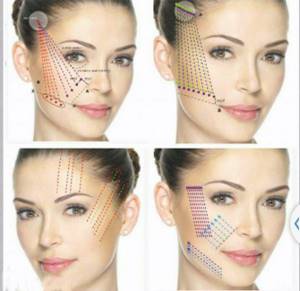
The price of the procedure depends on the quality and quantity of threads; it is different for each patient
How does the procedure work?
Before starting the procedure, the doctor disinfects the skin and gives anesthesia. If reinforcement is to be done with smooth threads that are placed shallowly, a cooling cream or gel is used as an anesthetic. Local anesthesia is administered under the barbed threads, usually an injection of lidocaine. According to the experience of women, this is the most painful part of the procedure - then the anesthetic begins to act, and almost no one feels pain while the skin is stitched with threads.
The implant thread itself is inserted into a thin cannula needle with a sharp end and quickly inserted under the skin according to a pre-drawn diagram (as a rule, the doctor draws the thread entry/exit points directly on the skin before the procedure begins). When the thread is placed, it needs to be secured. This is done in one of the possible ways:
- if the thread is smooth, it is attached using a knotted method - either to the bones or to dense and inactive subcutaneous tissue, onto which a surgical mesh made of biocompatible synthetic material is first applied. This method of fastening (like the smooth threads themselves) is practiced when lifting the body (chest, abdomen, hips, buttocks) - for better and reliable fixation of the supporting frame;
- if the thread is with clamps, it is simply pulled in the direction opposite to the one in which it was inserted under the skin. This way, knots, hooks or cones placed along the entire length of the implant will “fit” into the right place, so that the ends of the thread do not have to be fixed.
How much the procedure will cost depends on:
- depending on the type of thread;
- on their quantity;
- from the clinic;
- from the doctor's qualifications.
Prices for thread lifting can vary greatly even within Moscow and the Moscow region.
What does the skin look like after thread lifting and how to care for it
Depending on the type of threads, the person after the procedure may require rest for several days - there will be slight swelling and slight (2-3 mm) cyanosis around the puncture sites. Hematomas may be observed along the threads. The rehabilitation period can last for 1-2 weeks.
However, these changes are not mandatory: the thread lifting procedure in some clinics is called “weekend facelift”: the patient performs it, say, on Saturday, and on Monday at work with a “new” face she collects compliments from colleagues.
Your doctor should give you recommendations on your regimen and skin care after the procedure.
— When performing thread lifting on the face, on the first day you are allowed to sleep only in a semi-sitting position and on your back.
— During the first seven days, it is prohibited to carry out any facial procedures or massages.
- You should limit any physical activity during the week
— You should wash your face, apply creams or makeup after lifting very carefully.
— Fans of saunas, steam baths and solariums will have to refuse to visit them for ten days. Local thermal procedures on the areas where threads are introduced are not recommended within the next month after thread lifting.
The doctor may prescribe painkillers (ketanov, nurafen) if severe pain and discomfort occur in the lifting area. The doctor may also prescribe antibiotics and treat the thread insertion sites with an antiseptic.
Types of threads - table
| Thread type/Characteristics | What are they made of? | Absorbable/non-absorbable | Form | Cost (for 1 piece) | What area are they suitable for? | Validity |
| Metal threads |
| Do not dissolve | Smooth, without notches | From 10800 rub. | Face, décolleté, abdomen, back of hands | Up to 5 years |
| Spring Tread |
| Do not dissolve | Notched | From 15,000 rub. | Face | 3–5 years |
| Tissulift |
| Dissolve within a year | Braids (braids), without notches | 3500–5000 rub. | Face, inner shoulders, buttocks, thighs | 3–5 years |
| Mesothreads (3D mesothreads) |
| Dissolves after 6 months | Smooth/notched | 800–1500 rub. | Face, arms, thighs, buttocks | Up to 2 years |
| Dermafil happy lift | Biosynthetic material caprolac | Dissolves within 6–9 months | Notched | 20,000 rub. | Face, neck, décolleté | 3–5 years |
| Silhouette Lift | Polypropylene | Dissolves after 6 months | Smooth, with cones | 6000–8000 rub. | Face, buttocks | Up to 5 years |
| Silhouette Soft |
| Dissolve - first the fixatives, then the threads themselves | Smooth, with cone locks | 13,000–15,000 rub. | Face | Up to 5 years |
| Aptos | Polypropylene/caprolactone with added lactic acid | Both soluble and insoluble | Notched | 1400–2500 rub. | Face, hands | From 2 years for absorbable sutures to 5 years for non-absorbable sutures |
What implants look like - photo gallery
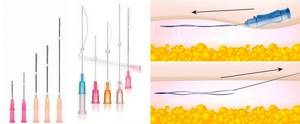
Silhouette Lift threads are attached using knots and cones
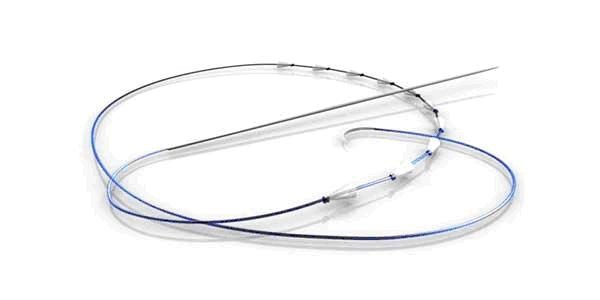
Dermafil happy lift threads are one of the most expensive absorbable threads
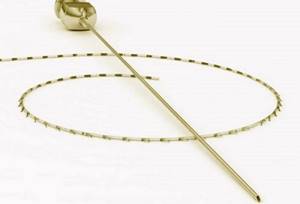
Gold threads are almost never used today; synthetic implants are more popular
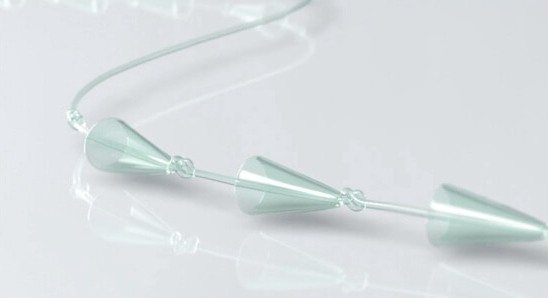
Consoles with Silhouette Soft thread allow for stronger fixation of the implant in soft tissues
Possibilities of thread lifting
You should not expect instant results from thread lifting. The face will change immediately after the installation of implants - this is a fact, but the result can be assessed no earlier than 3-4 weeks, when the swelling has completely gone down and the internal cuts (thread insertion channels) have healed.
Primary improvements:
- reduction of visible wrinkles;
- restoration of a beautiful facial contour;
- raised cheekbones (if the threads were placed in this area);
- elimination of facial asymmetry (if any was observed).
Over time, these positive changes will only become more noticeable - there will be fewer wrinkles, the skin, after being restored, will become more even, smoother, and visually the face will look younger by 2-3 years for sure (radical rejuvenation - by 5 or even 10 years, with It is impossible to achieve this with the help of threads - doctors do not hide this). Implants installed on the body eliminate wrinkles on the hands (on the back of the hands), tighten the skin on the neck, forearms, décolleté, abdomen and thighs.
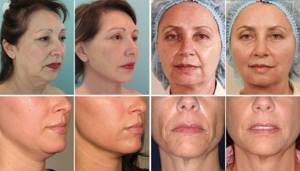
Thread lifting is more in demand for face lifting; placing threads on the body is ineffective
Benefits of lifting and types of threads
Photos before and after a thread facelift can be seen in this article, as well as on many forums discussing the effectiveness of the procedure. In addition to the obvious natural effect of rejuvenation, such lifting leaves absolutely no scars, does not require any incisions or excision of the skin, minimizing trauma. The procedure is also performed under local anesthesia, and you can go home immediately after it.
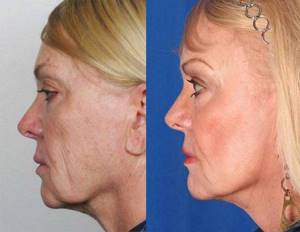
Today, the threads used for non-surgical facelift are divided into:
- non-absorbable;
- absorbable;
- long-term dissolving;
- conical;
- combined.
Each type will be discussed in detail below.
Rehabilitation period
While you are recovering from the procedure, strictly follow all the doctor's recommendations. The success (failure) of a thread lift depends on your level of discipline. For almost a week you will have to limit yourself to food (try to eat liquid and warm - not hot), talk as little as possible (and if you talk, then without emotions and facial expressions) and control yourself at night - sleep only on your back.
Two to three days after the procedure are usually the most painful; at this time, the threads under the skin are especially felt, and this sensation is not pleasant. There is usually no severe pain if rehabilitation proceeds without complications. To avoid displacement of the threads, doctors recommend wearing a compression bandage - it can also cause some discomfort, but for the sake of the result it is worth being patient. The puncture sites (the beginning and end of the threads) need to be lubricated daily with an antiseptic - Miramistin or Chlorhexidine - until they heal. For 3-4 weeks after the procedure, it is advisable to avoid visiting the pool, solarium and gym, and avoid performing any rejuvenating and skincare procedures in the salon.
Possible complications
- Changes in facial expressions can be caused by the effect of anesthesia; if this does not go away after three days, it is recommended to consult a specialist;
- Swelling in the first few days after the insertion of threads. To eliminate these unpleasant symptoms, it is recommended to use cold compresses;
- A feeling of pain that is relieved by painkillers prescribed by the surgeon;
- The feeling of tension is caused by increased swelling and pressure, this sensation goes away on its own after the swelling is removed;
- Blue discoloration appears due to damage to small capillaries, hematomas are especially noticeable if the procedure was performed on the eve of menstruation;
- Skin unevenness can persist for about 10 days, after which the skin is evenly redistributed along the threads;
- Rarely, an allergy to the material from which the threads are made may occur;
- Infection, distortion of the oval of the face, translucency of threads and their movement, all this can occur due to incorrect actions of the surgeon.
What health consequences can there be after thread lifting?
Thread lifting does not occur without consequences. For most patients, these consequences are predictable and include:
- bruises and hematomas that disappear within 1–1.5 weeks. Appear as a result of internal bleeding from capillary threads damaged during installation;
- tissue swelling that subsides on the third day (plus or minus one day);
- disturbance of facial activity, when it is difficult to express familiar emotions with facial expressions. Usually observed while the anesthesia wears off;
- the effect of hypercorrection, when it seems that the skin is overstretched and the face looks unnatural. This is often a deliberate medical maneuver designed to counteract the inevitable subsidence of tissue under the influence of gravity. Within a few days after the tightening, the tissues themselves lower slightly and take a natural position.
Much less often, thread lifting results in health problems for the patient:
- if the threads have moved, bumps and pits are visible on the skin - due to the fact that the tissue is unevenly distributed along the thread;
- if the patient is allergic to the anesthetic and (or) suture material, a rash and irritation will immediately appear in the reinforcement area. First aid is to take antihistamines, then be sure to consult the doctor who inserted the threads;
- inflammation of the channels where the threads are placed. First aid is to take antibiotics if the abscess is extensive. the threads are usually removed;
- the threads contour, that is, they appear under the skin - either completely, or only the ends. The problem can only be solved by removing the entire implant or its fragment;
- the threads shift and “migrate” in the subcutaneous layer - usually this does not happen immediately after the procedure, but six months or a year later. In any case, the implants are removed.
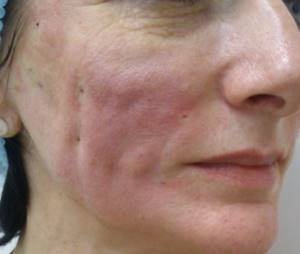
If reinforcement is unsuccessful, the thread may contour - appear under the skin - either entirely or only at the ends
Pros and cons of thread lifting - table
| + | — |
|
|
Features of the technology
Facial rejuvenation with threads, tightening of contours and individual problem areas of the skin is widely popular among women of different ages. The procedure consists of structuring a new frame using special threads directly in the internal tissues of the epidermis. Subsequently, connective fibers form on them, holding the contours in a tightened position.
To speed up the process of tissue renewal after rehabilitation, it is recommended to use cosmetics made from natural essential oils, tightening gymnastic exercises, and classical massage.
There are several types of procedure, depending on the material. The following types of facial threads are used:
- self-absorbable - made from complex lactic acids. Such threads are convenient because they dissolve after a certain period of time, when the formation of a framework of cells is already completed;
- non-absorbable - the material used is synthetic fibers (Teflon threads) or precious metals (Aptos gold threads). They do not dissolve and remain in the layers of the epidermis for the remaining years. Such materials are suitable for rejuvenating problem areas that require intensive, decisive skin tightening (especially common for the neck and décolleté);
- combined type - combines the previous two. They partially dissolve, but the core of the thread remains, which supports the resulting cellular framework.
Possibility of combining thread lifting with other types of rejuvenation
Thread lifting can be combined with other salon procedures, such as:
- biorevitalization;
- mesotherapy;
- botulinum therapy;
- laser skin resurfacing.
It is only important to complete the full course of these procedures before installing the threads. This way the skin will receive the necessary nutrition and hydration, and the results from the installed implants will be more pronounced. After reinforcing the threads until the tissue is completely restored, rejuvenating and healing procedures are contraindicated.
Rehabilitation
The duration of tissue restoration depends on the patient’s age and the rate of regeneration of his cells. The professionalism of the specialist who carries out the thread lifting procedure and the quality of the materials play an important role in the rapid rehabilitation of the patient. Immediately after the procedure, swelling and pain may remain on the face. This is a normal reaction of the body. To reduce swelling, cold is applied to the face, and to relieve pain, the surgeon prescribes painkillers.
